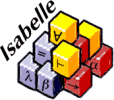General
Isabelle supports the three main platform families: Linux, Windows, Mac OS X. The platform-specific application bundles include sources, documentation, and add-on components. A few extra dependencies are explained below.
The raw Isabelle distribution archives are available for completeness, but assembling them by hand is not recommended! Past releases are available from the archive. Further technical background information may be found in the Isabelle System Manual.
Warning: Pre-packaged versions of Isabelle and some add-on components that are floating through the web as deb, rpm, port etc. are typically incomplete and outdated!
Linux
Requirements
- Isabelle2014_linux.tar.gz
- Perl 5.x with libwww
- Python 2.x
- LaTeX (optional, for document preparation)
- 32-bit C/C++ standard libraries on 64-bit Linux (optional, for improved performance of Poly/ML)
- Window manager / Desktop environment that works with Java/AWT/Swing
Installation
The bundled archive contains everything required for Isabelle on Linux. It can be unpacked into an arbitrary directory like this:
- tar -xzf Isabelle2014_linux.tar.gz
The Isabelle/jEdit Prover IDE can be invoked like this:
- Isabelle2014/Isabelle2014
Other Isabelle command-line tools can be invoked from the terminal like this:
- Isabelle2014/bin/isabelle
Windows
Requirements
- Isabelle2014.exe
- LaTeX (optional, for document preparation), e.g. see MikTeX
Installation
The self-extracting archive contains everything required for Isabelle on recent Windows systems. It can be unpacked into an arbitrary directory. The installer starts the Isabelle/jEdit Prover IDE automatically for the first time. It also creates a desktop alias to the main executable for later use.
Isabelle2014\Cygwin-Setup allows to modify the Cygwin installation of Isabelle, e.g. to add further packages manually.
Isabelle2014\Cygwin-Terminal allows to run Isabelle command-line tools, as known from Unix.
Mac OS X (10.9, 10.8, 10.7)
Requirements
- Isabelle2014.dmg
- LaTeX (optional, for document preparation), e.g. see MacTeX
Installation
The disk image contains an application bundle with everything required for Isabelle on recent Macs (64-bit). The Isabelle application can be placed into the /Applications folder and started as usual. Note that the target directory needs to be writable when Isabelle is started for the first time, to build the required logic image.
The main Isabelle distribution is hidden inside the Isabelle2014.app folder. This is relevant when invoking Isabelle command-line tools, e.g. like this in the Terminal application:
- /Applications/Isabelle2014.app/Isabelle/bin/isabelle

